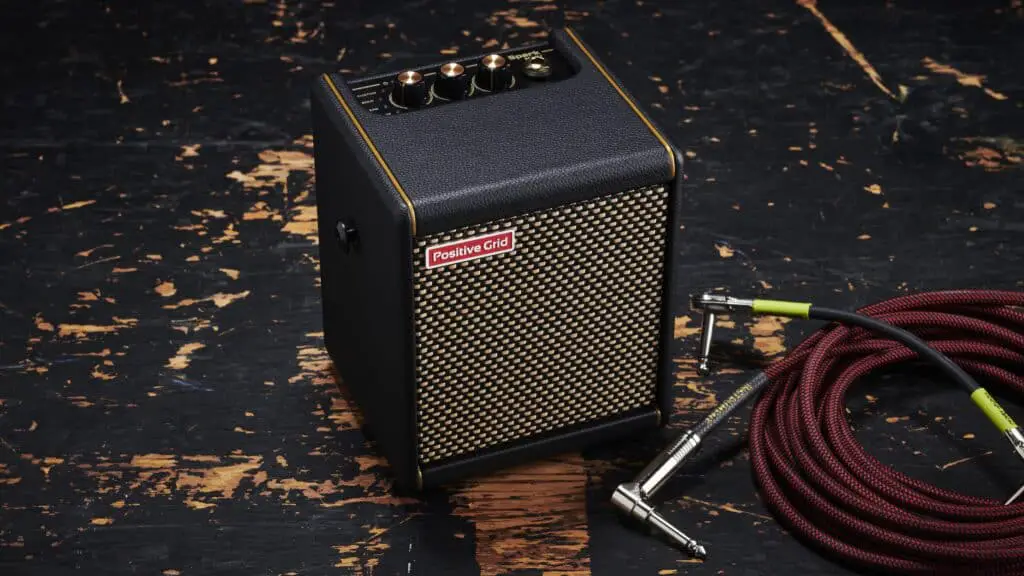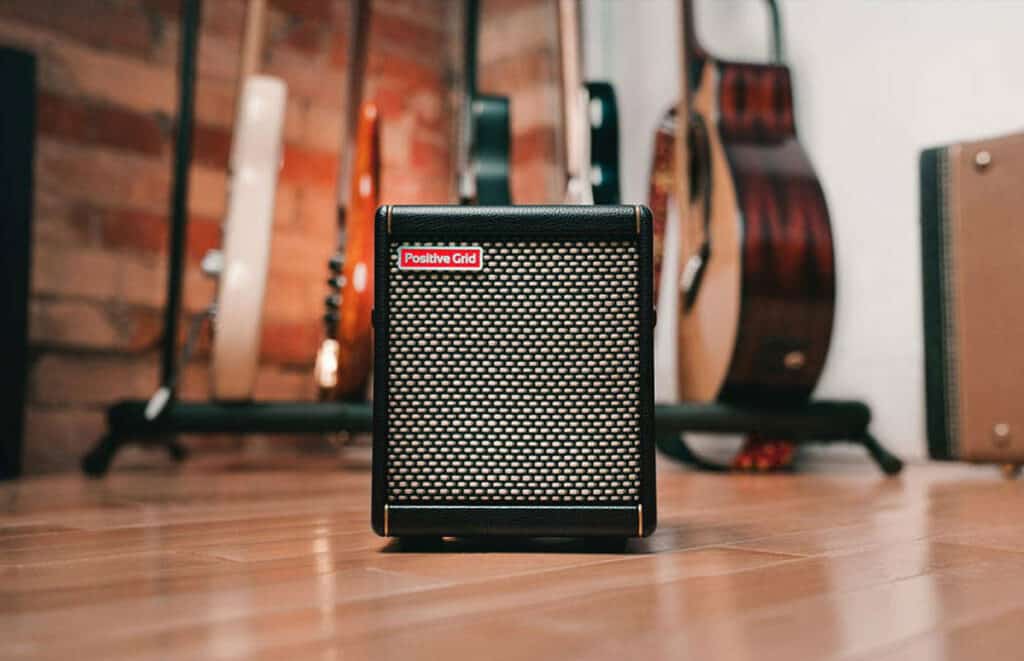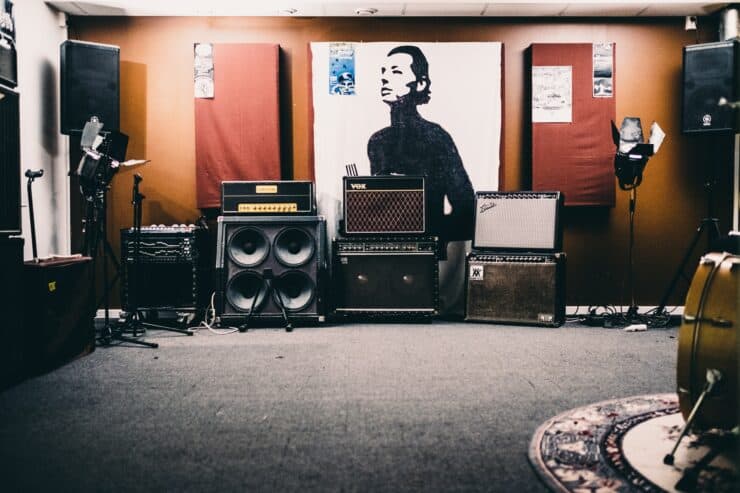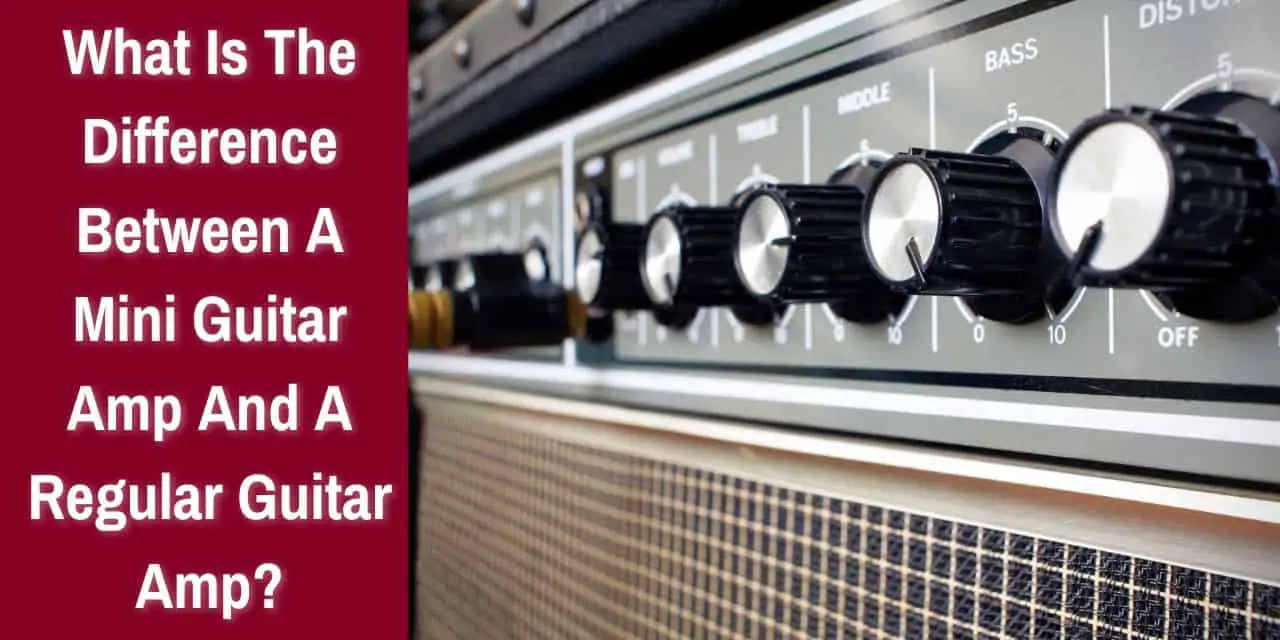Playing the guitar is a great way to express yourself, but if you want to be heard beyond your bedroom, you need an amp. Not all amps are the same, however, and it’s important to understand the difference between a mini guitar amp and a regular guitar amp. If you want to take your guitar playing to the next level, read on to learn more about the differences between these two types of amps.
Overview of a mini guitar amp
For musicians and guitarists, the quest for the perfect sound does not end with the choice of the instrument alone. The guitar amp also plays a key role in shaping the overall tone and delivering the desired sonic experience. While traditional guitar amps offer power and versatility, the emergence of mini guitar amps has truly captured the attention of musicians looking for portability and convenience without compromising on sound quality.
A mini guitar amp or also known as a practice amp is a compact and lightweight amp designed specifically for guitarists who need portability without sacrificing quality sound. These amps are typically smaller in size, which makes them ideal for home practice, small gigs, busking, or situations where space is limited. Although they might not produce the same volume as their larger counterparts, mini guitar amps still excel in providing convenience and portability, and come with an impressive array of features.
>>> Click here to read our review about the Top 15 Best Mini Guitar Amps <<<
The defining characteristic of a mini guitar amp is its compact size. These amps are designed to be extremely lightweight and easy to transport, which makes them perfect for guitarists on the move. Their small form factor allows them to fit into backpacks, gig bags, or even be carried by hand, ensuring that you can take your sound with you wherever you go.
These amps also have lower power output compared to large amps. While this might limit their use in large venues or band performances, it allows for quieter practice sessions and makes them suitable for small-scale performances, home recordings, or intimate gatherings. Despite their lower wattage, many mini amps offer surprising volume and tonal versatility.
Moreover, they come packed with a wide range of features and effects. Many models include built-in digital effects like delay, reverb, and modulation, which allow you to experiment with different tones and textures. Some mini guitar amps also offer headphone jacks for private practice, auxiliary inputs for playing along with backing tracks, and USB connectivity for recording or direct connection to a computer.
Since they are powered by batteries, you’ll get to enjoy the luxury of true portability. This feature allows musicians and guitarists to play and practice whenever they desire without having to look for power output. Moreover, many mini guitar amps can also be powered through an AC adapter, giving users the flexibility to choose between battery and mains power. They are also quite affordable, which makes them a great option for beginners, students, and musicians on a budget. Despite their lower price range, they still deliver impressive sound quality and feature-rich functionality.

Overview of regular guitar amps
The regular guitar amp is also an indispensable piece of equipment for musicians and guitarists of all skill levels. It serves as the gateway between their instruments and the amplification system, allowing them to properly express their creativity through amplified sound.
A regular guitar amp or short for amplifier is an electronic device designed for boosting the low-level electrical signal generated by an electric guitar or other amplified instruments to a level that can be played through speakers or headphones. Its primary function will be to amplify the guitar’s signal, emphasizing certain frequencies, and adding tonal coloration, texture, and effects to shape the sound according to the player’s preferences. A regular guitar amp consists of a preamp section, a power amp section, and a speaker cabinet.
The preamp section is the initial stage of a regular guitar amp and it is responsible for amplifying weak electrical signals produced by the guitar’s pickups. It typically consists of tone controls, gain, and volume knobs, and sometimes built-in effects. The preamp determines the tonal characteristics and shapes the overall sound of the guitar.
The power amp section receives the preamplified signal from the preamp and boosts it further to a level that can drive the speakers. It is responsible for delivering the amplified signal with sufficient power and dynamics. The power amp section influences the overall volume and responsiveness of the guitar amp.
The speaker cabinet is an important part of a regular guitar amp and it can house one or more speakers. It plays a key role in projecting the sound produced by the amp. The choice and configuration of speakers greatly impact the tonal characteristics, frequency response, and overall sonic experience of the guitar amp.
Regular guitar amps also feature a range of tonal controls, including Equalization knobs or sliders. These controls allow you to shape the sound by adjusting the levels of bass, midrange, and treble frequencies. The EQ section will allow you to achieve the desired tonal balance and tailor the sound to suit different musical genres and playing styles.
They also come with built-in effects like delay, reverb, chorus, or overdrive/distortion. These effects add depth, ambiance, and coloration to the guitar’s sound, expanding the creative possibilities for musicians. Having these effects directly integrated into the amp simplifies the setup and provides immediate access to a variety of tones.
Modern regular guitar amps often provide a wide range of connectivity options. These can include inputs for additional instruments or microphones, outputs for headphones or external speakers, and auxiliary inputs for connecting external devices like smartphones or music players. The versatility in connectivity will allow you to integrate the amp into various setups and collaborate with other musicians or playback tracks.
What is the difference between a mini guitar amp and a regular guitar amp?
When it comes to amplifying your electric guitar, selecting the right amp will be important. Two popular options in the market are mini guitar amps and regular guitar amps. While both of them serve the same function of amplifying your guitar, they differ in numerous aspects. This is why you’ll need to know what is the difference between a mini guitar amp and a regular guitar amp. Here are the differences between a mini guitar amp and a regular guitar amp, helping you make an informed decision based on your needs and preferences.

Power rating
Power rating refers to the wattage output of a guitar amp, which determines its volume and headroom capabilities. Regular guitar amps typically come with higher power ratings, ranging from 15 watts to hundreds of watts. This higher power will allow them to produce louder volumes and handle larger venues or band rehearsals.
Meanwhile, mini guitar amps typically come with lower power ratings, ranging from 1 to 20W. This makes them more suitable for home practice or intimate performances.
Speaker size
Speaker size plays a key role in shaping the overall sound and projection of an amp. Regular guitar amps commonly feature larger speakers like 10-inch, 12-inch, or even 15-inch models. The larger speaker size results in a fuller and more powerful sound, providing enhanced low-end response and overall resonance.
On the other hand, mini guitar amps come equipped with smaller speakers, ranging from 3 inches to 8 inches. While they might lack the same level of low-end presence as regular guitar amps, smaller speakers can still deliver punchy and focused tones, especially in close-quarters settings.
Tone controls
Tone controls allow guitarists to shape the frequency response and tonal characteristics of their amplifier. Regular guitar amps typically offer a wide range of tone controls, including bass, mid, and treble knobs as well as presence and resonance controls. These extensive tone-shaping options enable precise adjustments for achieving the desired sound.
Mini guitar amps have a compact size, which is why they have fewer tone controls. They are usually limited to basic EQ knobs like bass and treble. While they might offer fewer options, mini amps can still provide sufficient control over your tone.
Effects
Effects play a key role in shaping the sonic palette of a guitarist. Regular guitar amps often feature built-in effects like reverb, delay, chorus, and modulation effects. These integrated effects provide convenience and easy access to a wide variety of sounds without the need for external pedals.
Meanwhile, mini guitar amps generally come with fewer built-in effects because of their smaller size. However, many models from brands like Boss, Vox, etc. do offer basic effects like delay and reverb. This will allow you to add some ambiance and depth to your tone.
Connectivity
Connectivity options are important for integrating your amp with other devices and accessories. Regular guitar amps typically offer an impressive range of connectivity options, including multiple input/output jacks, headphone outputs, effects loops, and external speaker outputs. These versatile connections will allow you to connect pedals, recording devices, headphones, and additional speakers with ease.
Mini guitar amps might be more compact but they still provide essential connectivity options like auxiliary inputs. This will allow you to play along with external music sources and headphone outputs for silent practice.
Benefits of mini guitar amps
As a guitarist, it can be quite a challenge to find the perfect balance between portability and quality sound. Fortunately, the advent of mini guitar amps has revolutionized the way musicians play and perform. Mini guitar amps offer a myriad of benefits that cater to the needs of both amateurs and professionals alike. Here are some of the benefits of mini guitar amps and why they have managed to become such a game-changer in the world of guitar playing.
#1. High portability factor
One of the biggest benefits of mini guitar amps is their high level of portability. These point-sized amps are lightweight and compact, which makes them incredibly easy to transport. Whether you are a gigging musician, a frequent traveler, or simply want the convenience of practicing wherever you go, a mini guitar amp will be a great choice. You’ll be able to effortlessly carry it in your backpack or a gig bag and play your guitar anytime, anywhere.
#2. A surprising amount of versatility
Despite their small size, mini guitar amps pack a surprising punch when it comes to versatility. They often come with a wide range of tones and effects, allowing you to experiment and explore different sounds.
Most mini guitar amps come equipped with multiple channels, allowing you to switch between clean, overdrive, and distortion tones, allowing you to achieve a diverse range of sounds suitable for various genres. Moreover, many models include built-in effects like delay, reverb, and modulation, further expanding your creative possibilities.

#3. A wonderful asset for your practice sessions
Mini guitar amps can be an invaluable practice tool for guitarists of all levels. These amps offer a convenient way of honing your skills without disturbing others. Whether you are practicing late at night or in a shared living space, the headphone output feature will allow you to plug in your headphone and practice silently without sacrificing the quality of sound.
Moreover, mini guitar amps also come with auxiliary inputs, allowing you to connect your smartphone or MP3 player and play along with your favorite tracks, enhancing your learning experience.
#4. Recording capabilities
Another advantage of mini guitar amps is their ability to serve as recording tools. With built-in USB or line outputs, you’ll be able to easily connect the amp to your computer or audio interface and capture your guitar playing directly into digital recording software.
This feature is especially beneficial for home studio setups, allowing you to create high-quality recordings without the need for a separate mic or complex setup.
#5. Cost-effective amp option
Mini guitar amps are also more affordable than their larger counterparts, which makes them a great choice for musicians and guitarists on a budget. Despite their smaller size, these amps are capable of delivering impressive sound without breaking the bank.
They provide a cost-effective solution for beginner guitarists who are starting their musical journey or musicians looking for a secondary amp for smaller venues or practice sessions.
Benefits of regular guitar amps
When it comes to the world of electric guitars, a reliable and powerful guitar amp is an essential component in achieving the desired sound. Regular guitar amps have been the backbone of countless iconic performances, recording sessions, and practice sessions. Here are some of the primary benefits of regular guitar amps that have ensured it remains a cornerstone for guitarists of all genres and skill levels.
#1. Incredible sound quality and power
One of the primary advantages of regular guitar amps is their ability to deliver high-quality sound and power. Designed specifically for electric guitars, these amps offer a wide range of tones, from clean and crisp to heavily distorted, allowing guitarists to shape their desired sound.
Regular guitar amps come equipped with larger speakers and higher wattage, allowing them to produce greater volume and fill larger venues with ease. The combination of power and sound quality ensures that your guitar tone cuts through the mix and captivates the audience.
#2. Versatility and customization
Regular guitar amps offer a wealth of versatility and customization options to suit different musical styles and preferences. They typically come with multiple channels that allow you to switch between different sounds and tones.
From the clean channel for a pristine sound to the overdrive and distortion channels to get a heavier tone, you’ll be able to effortlessly dial in the desired settings to match the style of music you are playing. Moreover, regular guitar amps also feature onboard equalization controls, allowing you to shape the frequencies to your liking and adapt to different playing environments.
#3. Dynamic response
One of the biggest benefits of regular guitar amps is their dynamic response. These amps respond to the nuances and subtleties of your playing, capturing the expressiveness and intricacies of your performance.
When you dig into the strings with force, these amps will respond with increased volume and saturation, replicating the natural dynamics of a tube amp. This responsiveness will add depth and dimension to your playing, allowing you to convey emotion and intensity through your instrument.
#4. Performance and live sound
Regular guitar amps are a staple for live performances, delivering the needed power and projection to captivate audiences. Whether you are playing in small venues or large arenas, these amps will ensure that your guitar is heard and felt throughout the venue.
Regular guitar amps are often equipped with additional features like effect loops, which allow you to integrate external effects pedals seamlessly. This flexibility allows you to shape the sound further and create a captivating performance that resonates with your audience.
#5. Impressive recording capabilities
Regular guitar amps truly excel in recording scenarios, offering excellent sound quality for studio environments. With their dedicated speaker cabinets and microphone placements, regular amps allow engineers to capture the true essence of your guitar’s tone during recording sessions.
They offer a versatile range of tones and can be mic’d up in different ways, allowing audio engineers to experiment with different sonic textures and achieve the desired sound for a recording.
How to choose between a mini guitar amp and a regular guitar amp?
When it comes to choosing the ideal amp for your electric guitar, a number of factors come into play. There are different options that you can go for, including mini guitar amps and regular guitar amps. To make a smarter decision, it’ll be important to know how to choose the right amp. Here are the different considerations that you should keep in mind as they’ll help you find the perfect match for your musical needs.
Considerations for different types of music
Different music genres often require distinct tones and sonic characteristics. Mini guitar amps and regular guitar amps cater to different music genres. Mini guitar amps are more suited for blues, jazz, and light rock. Meanwhile, regular guitar amps are ideal for rock, metal, and heavy genres.
Mini guitar amps can excel in blues, jazz, and light rock genres due to their warm and smooth tones. These amps often produce cleaner and more compressed sounds, which are suitable for intricate playing styles and nuances dynamics.
These amps are also a great choice for personal practice sessions, allowing you to enjoy a reasonable volume without disturbing others. Their compact size and headphone outputs make them perfect for silent practice.
Regular guitar amps are renowned for their high-gain capabilities. This makes them perfect for aggressive and distortion-heavy music such as rock, metal, and heavy genres. These amps offer the necessary power and headroom to deliver the intense and impactful tones needed in these genres.
Regular guitar amps are also designed for larger venues and band settings. They offer higher wattages and larger speaker sizes. Moreover, they’re able to project your sound effectively and cut through the mix, ensuring that your performance is heard by everyone.
Budget considerations
Budget is another important factor when looking to purchase any new guitar amp. Mini guitar amps are more budget-friendly for guitarists but regular guitar amps offer more features and long-term use.
Mini guitar amps are generally more budget-friendly in comparison to regular guitar amps. These amps offer an economical solution for beginner musicians or guitarists on a limited budget. They also come with built-in effects, eliminating the need to go for separate pedals. This can save you a lot of money, especially if you are starting from scratch.
Regular guitar amps offer a lot more versatility, power, and features, which makes them a viable long-term investment. While they might be a pricier option upfront, they still offer the necessary tools to grow as a musician and adapt to different playing situations.
These amps are often built with higher-quality components, ensuring durability and consistent performance over time. This can end up saving you a lot of money in the long run by minimizing the need for repairs or replacements.
FAQs
What is the main difference between a mini guitar amp and a regular guitar amp?
The main difference between a mini guitar amp and a regular guitar amp is size. Mini guitar amps are typically smaller in size and have fewer features than regular guitar amps. They are usually designed for practice and are great for those who need to practice at home or on the go. Regular guitar amps are larger and usually have more wattage and features for live performance.
What are the benefits of using a mini guitar amp?
Mini guitar amps are typically smaller, lighter, and more portable than regular guitar amps, making them ideal for practice at home or on the go. They are also more affordable and often have features such as headphone jacks, allowing for silent practice.
When should I use a regular guitar amp instead of a mini guitar amp?
A regular guitar amp is typically used for live performance and is designed to provide a more powerful sound with greater volume and projection. They also usually have more wattage and features for live performance. If you are playing live or recording, it may be a good idea to use a regular guitar amp to get a more dynamic sound. However, if you are practicing at home or on the go, a mini guitar amp may be a more



